Portland Oregon Landscapers Talk Drainage Systems by Alex Konopka at Landscape East & West
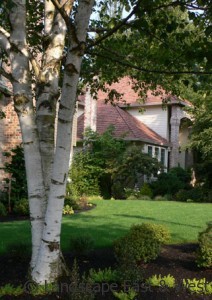 Standing ground water, leaky basements, a perpetually soggy lawn—these are all signs that your property has drainage problems that demand attention. As Portland, Oregon landscapers with more than 30 years of experience designing water management systems for our area, we’d like to warn you that drainage problems are one part of home management that should never be ignored. Water can cause real damage to your home and property. Don’t wait for an emergency to take care of your drainage situation. This post discusses different soil drainage solutions that are widely used in Portland. We provide examples of different drainage solutions, and offer some tips for best practices as well.
Standing ground water, leaky basements, a perpetually soggy lawn—these are all signs that your property has drainage problems that demand attention. As Portland, Oregon landscapers with more than 30 years of experience designing water management systems for our area, we’d like to warn you that drainage problems are one part of home management that should never be ignored. Water can cause real damage to your home and property. Don’t wait for an emergency to take care of your drainage situation. This post discusses different soil drainage solutions that are widely used in Portland. We provide examples of different drainage solutions, and offer some tips for best practices as well.
Drainage in Portland
If you live in Portland, you probably already know about some of the issues that affect soil drainage. Portland soils tend to contain clay. Heavy pockets of clay can make it hard for water to percolate through the soil. Also, the West Hills are notorious for drainage issues. With this area’s hills and sloped landscapes, it can be easy for water to pool, threatening nearby structures.
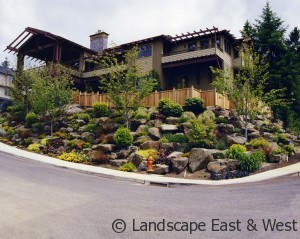 Regardless of your location in Portland, water management is a critical factor to consider, especially if you experience standing water in the yard, a leaky basement, or if your property is beneath a direct slope. Lawns can complicate poor drainage issues, so if you are considering putting in new turf, you definitely want to consider the surrounding runoff situation.
Regardless of your location in Portland, water management is a critical factor to consider, especially if you experience standing water in the yard, a leaky basement, or if your property is beneath a direct slope. Lawns can complicate poor drainage issues, so if you are considering putting in new turf, you definitely want to consider the surrounding runoff situation.
Landscape East & West offers professional landscape design. Portland, Oregon residents should not hesitate to give us a call about their drainage situations before a costly damage occurs. We handle sprinkler repairs, drainage problems, slope and soil stabilization, rainwater harvesting, and solutions as simple as firming up that soggy lawn so you don’t have to keep worrying about your pet tracking in mud.
Drainage Solutions
Typical drainage solutions include French drains, multi-flow systems, dry stream bed arrangements, flow wells, and specialized soil amendments. Below, we take a closer look at each of these drainage systems.
French Drains
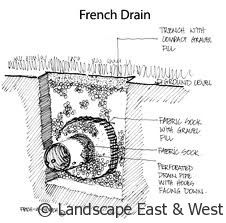 French drains take advantage of gravity. They consist of a buried perforated pipe and a gravel bed, installed at a depth of 12 to 18 inches. Gravity draws water into the French drain, thereby preventing pooling in problem areas. French drains can be challenging to install, as they tend to require extensive digging and removal of soil. Also, they are not always a complete solution as they do serve to move water away from problem areas, but the water must still be directed somewhere. We recommend directing French drains to flow wells or rain gardens.
French drains take advantage of gravity. They consist of a buried perforated pipe and a gravel bed, installed at a depth of 12 to 18 inches. Gravity draws water into the French drain, thereby preventing pooling in problem areas. French drains can be challenging to install, as they tend to require extensive digging and removal of soil. Also, they are not always a complete solution as they do serve to move water away from problem areas, but the water must still be directed somewhere. We recommend directing French drains to flow wells or rain gardens.
If a yard is too flat for gravity to work, French drains can also be partnered with sump pumps. An experienced drainage contractor like Landscape East West can install a French drain behind retaining walls, around the exterior of the house, or in any other location where standing water is a problem.
Multi-Flow
Multi-flow drainage systems are similar to French drains, but are often deeper (three or more feet underground), and are often used for larger projects, such as heavily used athletic fields and well-manicured lawns.
Dry Stream Bed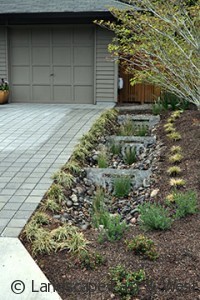
Dry stream beds let nature do the drainage work. In these systems, downspouts are typically disconnected and water flows into a recessed area. Water pools in the dry stream bed and gradually dissipates into the ground. Dry stream beds can be placed along the perimeter of a lawn, or along the side of a house. Pipe is often placed at the bottom of the stream bed, to further direct flow. The inclusion of pea gravel, river rock, small boulders, and native landscaping can create an aesthetically pleasing look.
Dry stream beds are also used in conjunction with rain gardens to collect water and utilize water-loving plants to help absorb run-off.
Dry Well/Flow Well
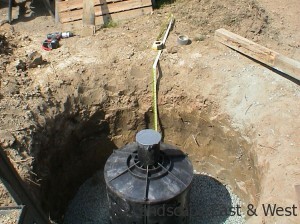 A dry well is a hole that is lined with landscaping fabric and filled with gravel, creating an area where water will collect and percolate down into the soil. Dry wells are often placed at the conjunction of several French drains; one may collect water, while another provides backup drainage. This creates a system that can handle larger volumes of water than a single French drain.
A dry well is a hole that is lined with landscaping fabric and filled with gravel, creating an area where water will collect and percolate down into the soil. Dry wells are often placed at the conjunction of several French drains; one may collect water, while another provides backup drainage. This creates a system that can handle larger volumes of water than a single French drain.
Soil Amendments
Sometimes the best solution for a drainage problem is to amend the soil to take on characteristics of the native soil. By tilling in gravel, sand, or compost into the clay soil, you can create layers that will allow the surface water to drain and seep down to the natural water table. The type of amendment needed for your soil can be determined quickly after analyzing a few core samples.
Water Management Best Practices
- Make sure the water goes somewhere. If you hire a contractor they will need to ascertain the proper percentage slope so that the water does not puddle up.
- Custom design your drainage solutions for your exact location. Each area in Portland is distinct—some areas are flat, while other spots have great drainage thanks to slopes. Landscape East & West is familiar with the local areas and has vast experience not only in Portland, but Lake Oswego, Clackamas, Hillsboro, and other surrounding areas.
- If your yard is all muck, consider adding soil amendments. Soil amendments can change the composition of the soil, making it easier for water to drain.
- If only one area of your yard (such as a patio) has drainage problems, a simple French drain may be the solution.
- For lawns with standing water or mucky soil, consider a turf renovation project over a French drain.
- Installing a French Drain is not technically difficult, but does require plenty of digging and earth removal. Make sure the percolation holes point down, and be sure to use the right fabric protection to keep dirt and debris out of the drainage system.
- Make sure you use the right type of pipe for your specific situation. Black flexible pipe is used often, but in the wrong application debris can become stuck inside, impeding drainage. Smooth wall pipe contains 2 nickel-sized holes installed at 45 degree angles; this type of pipe tends to become clogged less often.
A Holistic Approach
Drainage solutions call for a holistic approach, as a problem with one area of your landscape or property could affect other areas as well, creating a chain reaction. Here at Landscape East & West, our expert technicians take a holistic approach by looking at your entire landscape to gain an understanding of how water flows through the whole system. We make sure that we do it right the first time, so that you don’t have even bigger problems down the road.
Water in Portland
With all the rain that Portland gets, it is easy to see why drainage can be a problem. Improper run-off management can have long-term negative effects on a building or property. These include damage to the foundation, mold and mildew build up, dead trees and shrubs, and other problems associated with constant moisture. Gutters, downspouts, and drainage pipes work to collect water and whisk it away, but if any one of these fails you’ll have a mess on your hands. Don’t wait for an emergency to happen. Contact our experts at Landscape East West to schedule a consultation today. Our experts are here to analyze, discuss, and improve your specific drainage situation.
 Contributing author Alex Konopka is a Design & Sales Associate at Landscape East & West, Portland landscaping and design professionals. Alex has a wealth of experience assisting clients with drainage and installation, irrigation repair and more. Learn more about Landscape East & West’s water management services.
Contributing author Alex Konopka is a Design & Sales Associate at Landscape East & West, Portland landscaping and design professionals. Alex has a wealth of experience assisting clients with drainage and installation, irrigation repair and more. Learn more about Landscape East & West’s water management services.
